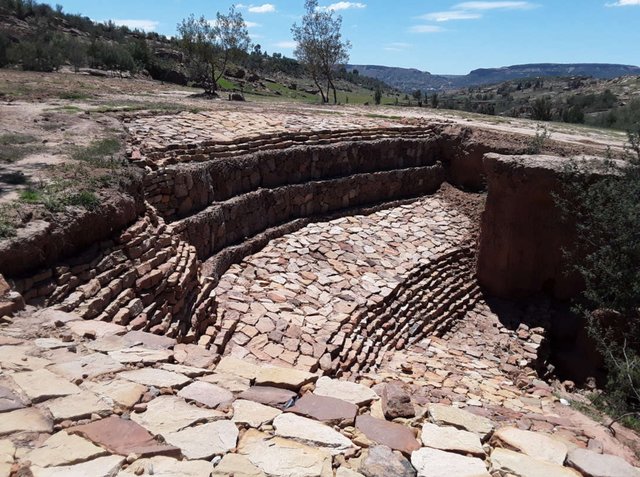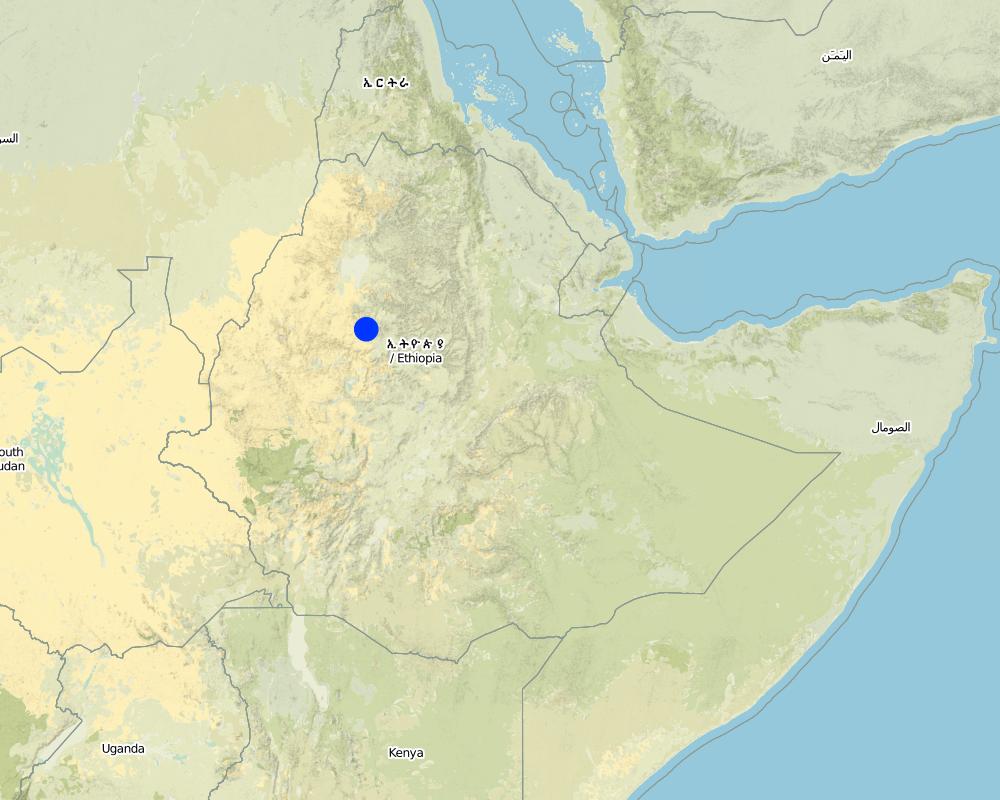Social Infrastructure for Soil Conservation [埃塞俄比亚]
- 创建:
- 更新:
- 编制者: Hans Hurni
- 编辑者: –
- 审查者: Fabian Ottiger
approaches_2390 - 埃塞俄比亚
查看章节
全部展开 全部收起1. 一般信息
1.2 参与方法评估和文件编制的资源人员和机构的联系方式
有助于对方法进行记录/评估的机构名称(如相关)
CDE Centre for Development and Environment (CDE Centre for Development and Environment) - 瑞士1.3 关于使用通过WOCAT记录的数据的条件
编制者和关键资源人员接受有关使用通过WOCAT记录数据的条件。:
是
1.4 SLM技术问卷的参考

Gully head structure [莱索托]
The aim of the gully head structure is to help stabilise the gully and prevent/control the gully from expanding further in length due to erosion. In Lesotho, this is constructed using stones.
- 编制者: Matoka Moshoeshoe
2. SLM方法的描述
2.1 该方法的简要说明
Negotiation with the stakeholder community of a catchment on social incentives to be offered by external agency in exchange of additional inputs by the communty to be invested into soil and water conservation measures.
2.2 该方法的详细说明
该方法的详细说明:
Aims / objectives: The overall purposeof the approach is to achieve sustainable land management without direct incentives such as food-for-work, cash payment, etc. Instead, the community is contracted through a negotiation process to invest into conservation without any direct incentives. Instead, the community will be entitled to select a social investment in their territory which conforms to its most pressing needs, e.g. a clinic, a school, a road, etc. Specific objective is to persuade farmers of the virtue of sustainable land management without direct pay, and to show that outside help is tied to this long-term community commitment when investing into social infrastrcuture. In the end, this is a win-win situation because two goals are achieved with a much greater investment and commitment from the farmer side, while sustainable land management and social development are furthered.
2.5 采用该方法的国家/地区/地点
国家:
埃塞俄比亚
区域/州/省:
Gojam
Map
×2.6 该方法的开始和终止日期
注明开始年份:
1985
终止年份(若不再采用该方法):
1988
2.7 方法的类型
- 基于项目/方案
2.8 该方法的主要目的/目标
The Approach focused mainly on SLM with other activities (Area closure / cut & carry of grass. Clinic construction & facilitation.)
There is no document, but the SCRP goal is to support sustainable use of natural resources. In Anjeni this should be achieved through a specific incentive at social level.
The SLM Approach addressed the following problems: Accelerating soil erosion. Declining production of crops. Overland runoff destroying crops and producing gullies. Poor social infrastructure in community.
2.9 推动或妨碍实施本办法所适用的技术的条件
社会/文化/宗教规范和价值观
- 阻碍
lack of community collaboration
Treatment through the SLM Approach: further processes of community development
机构设置
- 阻碍
lack of trained extensionists
Treatment through the SLM Approach: training supprt
法律框架(土地使用权、土地和水使用权)
- 阻碍
lack of land ownership
Treatment through the SLM Approach: clarify ownership and user rights
The existing land ownership, land use rights / water rights hindered a little the approach implementation But not much. Attitudes of farmers towards investments into their land remain negative.
3. 相关利益相关者的参与和角色
3.1 该方法涉及的利益相关者及其职责
- 当地土地使用者/当地社区
Groups of users organised through the project; Working land users were mainly men (Some women and children also participated.)
Women were less involved in planning and implementation of SWC, but more with social infrastructure. In Ethiopia, men traditionally do soil labour in field. The approach included all communities including all households.
- 国家政府(规划者、决策者)
Ministry of Agriculture
Ministry of Health
- 国际组织
如果涉及多个利益相关者,请注明领导机构:
Expat: Overall principle of conservation for infrastructure approach. Nationals: Design of objectives, activities. Land users: Agreement on approach and specific designs of technology & maintenance.
3.2 当地土地使用者/当地社区参与该方法的不同阶段
| 当地土地使用者/当地社区的参与 | 指定参与人员并描述活动 | |
|---|---|---|
| 启动/动机 | 无 | |
| 计划 | 被动 | interviews/questionnaires |
| 实施 | 被动 | responsibility for major steps |
| 监测/评估 | 被动 | public meetings; |
| Research | 无 |
3.4 有关SLM技术选择的决策
具体说明谁有权决定选择要实施的技术:
- 主要是SLM专家,咨询土地使用者之后
解释:
consultative. Development of technology was based on existing indigenous technologies which were complemented and perennized. The approach was explained to the farmers, a 10ha demonstration area was established for one year, and the agreement was reached after that time to do it on 100 ha, if social infrastructure support was given.
Decisions on the method of implementing the SLM Technology were made by by SLM specialists alone (top-down). directive (top-down). Proposal by Development Agents was explained to farmers, and their consent used to organize the mass implementation campaign in 1987.
4. 技术支持、能力建设和知识管理
4.1 能力建设/培训
是否为土地使用者/其他利益相关者提供培训?:
是
明确受训人员:
- 土地使用者
- SWC specialists (2), extensionists/trainers (1), politicians/decision makers (1)
培训形式:
- 在职
- 示范区域
- 公开会议
涵盖的主题:
Technical design of SWC techniques. Institutions on maintenance & modifications.
4.2 咨询服务
土地使用者有权使用咨询服务吗?:
是
指明是否提供了咨询服务:
- 在土地使用者的土地上
说明/注释:
Name of method used for advisory service: Government Extension System.; Key elements: Holding of meetings., Technical layout of SWC techniques., Support in negotiations & follow-up.; 1) Mainly: government's existing extension system, Partly: projects own extension structure and agent; Extension staff: Mainly government employees 2) Target groups for extension: School children/students, Teachers; Activities: Demonstration visits to nearby catchment and preparation of a school b
Advisory service is inadequate to ensure the continuation of land conservation activities; Farmer to extensionist ratio is 1000:1 or worse. Educational status of all is low. Approach of extension still needs improvement.
4.3 机构强化(组织发展)
是否通过这种方法建立或加强了机构?:
- 是,适度
具体说明机构的强化或建立程度:
- 本地
具体说明支持类型:
- 设备
4.4 监测和评估
监测和评估是该方法的一部分吗?:
是
注释:
bio-physical aspects were regular monitored through observations
technical aspects were regular monitored through observations
socio-cultural aspects were regular monitored through observations
economic / production aspects were regular monitored through measurements
There were several changes in the Approach as a result of monitoring and evaluation: Technology was adapted according to farmers wishes, namely adjustments of narrow terraces by removing some, overlay of drainage system over terraces and not along them.
Monitoring & extension in still ongoing through SCRP, and since 1984 in Anjeni.
4.5 研究
研究是该方法的一部分吗?
是
明确话题:
- 社会学
- 经济/市场营销
- 生态学
- 技术
- Land use dynamics, farming system.
提供进一步的细节,并指出是谁做的研究:
The treated catchment of Anjeni is part of a research set-up where continuous monitoring and evaluation is being carried out since 1984.
Research was carried out on-farm
5. 融资和外部物质支持
5.1 该方法中SLM组成部分的年度预算
如果不知道准确的年度预算,请给出一个范围:
- 10,000-100,000
注释(例如主要的资助来源/主要捐助者):
Approach costs were met by the following donors: international (GDE/SCRP): 25.0%; government (national - Min. of Agriculture): 5.0%; local community / land user(s) (-): 70.0%
5.2 为土地使用者提供财政/物质支援
土地使用者是否获得实施该技术的财政/物质支持?:
是
5.3 对特定投入的补贴(包括劳动力)
- 设备
| 具体说明哪些投入得到了补贴 | 程度如何 | 对补贴做出具体说明 |
|---|---|---|
| 工具 | 充分融资 | Hand tools |
- 基建
| 具体说明哪些投入得到了补贴 | 程度如何 | 对补贴做出具体说明 |
|---|---|---|
| Community infrastructure | 部分融资 | Support to clinic was 50% of cost of clinic only. |
如果土地使用者的劳动力是一项重要的投入,那么是不是:
- 自愿
注释:
In exchange of SWC works support to clinic was given as an overall incentive.
5.4 信用
是否根据SLM活动的方法给予信用值?:
否
6. 影响分析和结论性陈述
6.1 方法的影响
该方法是否帮助土地使用者实施和维护SLM技术?:
- 否
- 是,很少
- 是,中等
- 是,支持力度很大
Traditional soil fertility management was already exhaustively used under the given farming system.
该方法是否改善了阻碍SLM技术实施的土地使用权/用户权问题?:
- 否
- 是,很少
- 是,中等
- 是,支持力度很大
The problem is unlikely to be overcome in the near future. Present government insists on state ownership of land.
Did other land users / projects adopt the Approach?
- 否
- 是,很少
- 是,中等
- 是,支持力度很大
A large programme in Merhabete involving 2,000 ha and about 10,000 people adopted a similar system, however with a technology that was suitable to their area (level bunds).
6.3 方法活动的可持续性
土地使用者能否维持通过该方法实施的措施(无外部支持的情况下)?:
- 否
若否或不确定,请具体说明并予以注释:
Social incentives will have to come from outside (government or NGO)
6.4 该方法的长处/优点
| 土地使用者眼中的长处/优势/机会 |
|---|
| Fulfillment of community needs (How to sustain/ enhance this strength: Co-ordination and participatory approach) |
| All catchment land users do conservation jointly together (How to sustain/ enhance this strength: Community versus individual approach) |
| 编制者或其他关键资源人员认为的长处/优势/机会 |
|---|
| Negotiation processes (How to sustain/ enhance this strength: Train extensionists) |
| Social incentives (How to sustain/ enhance this strength: Better cooperation between different ministries on their activities as a package) |
6.5 该方法的弱点/缺点以及克服它们的方法
| 土地使用者认为的弱点/缺点/风险 | 如何克服它们? |
|---|---|
| Combining two goals necessitates more labour inputs | No solution |
| 编制者或其他关键资源人员认为的弱点/缺点/风险 | 如何克服它们? |
|---|---|
| Tieing social investments with soil conservation is politically difficult because two goals are pursued with one instrument | No option but continue |
| Interest may still be initiated basically from need and less from degradation | Awareness needs to be furthered still |
7. 参考和链接
7.1 方法/信息来源
- 实地考察、实地调查
- 与土地使用者的访谈
7.2 参考可用出版物
标题、作者、年份、ISBN:
SCRP Progress Reports
可以从哪里获得?成本如何?
SCRP, Addis Abeba
标题、作者、年份、ISBN:
Book Learning from Anjeni' (Amharic)'
可以从哪里获得?成本如何?
Min. of Education, Bahr Dar
标题、作者、年份、ISBN:
SCRP Research Reports
可以从哪里获得?成本如何?
SCRP, Addis Abeba
链接和模块
全部展开 全部收起链接

Gully head structure [莱索托]
The aim of the gully head structure is to help stabilise the gully and prevent/control the gully from expanding further in length due to erosion. In Lesotho, this is constructed using stones.
- 编制者: Matoka Moshoeshoe
模块
无模块


